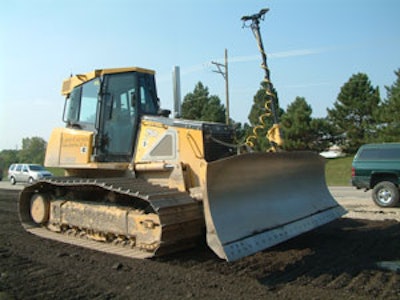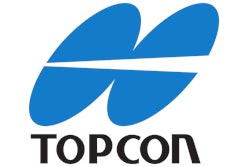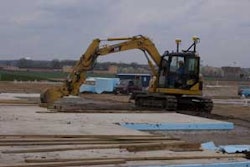
Even in good times, road building is a highly competitive industry, but when the general economy goes soft it becomes even more so. Then, experienced contractors find themselves competing for a smaller pool of projects both with each other, and with new competitors attracted to the market as a replacement for vanishing commercial work.
"We are always looking for a competitive advantage," says Ruben Cuevas, Chief Surveyor of Lake County Grading Co., LLC, in Libertyville, Ill., "and these days that usually comes in the form of advanced technology. I guess you could say we are classic 'early adopters'.
"We saw the value of GPS-based surveying technologies early on. We have had our own base stations and rovers for quite a while now. We keep jobsite information on laptops, and record things like undercuts and as-builts electronically on virtually all of our jobs.
"We also got onboard with GPS-based machine controls early on. In 2005 we equipped a pair of dozers with Topcon 3DMC systems as a test. Based on that experience, we now have nearly a dozen 3DMC-equipped dozers, and have recently added our first grader."
That background made Lake County Grading a natural candidate for the next step in the evolution of GPS-based surveying and machine control - networking. So, when their Topcon distributor, Positioning Solutions of Carol Stream, IL invited Lake County Grading to participate in a real-time Global Networked Satellite System (GNSS) machine control network they were building, the answer was a resounding "yes."
GNSS networks link a number of base stations together via a computer network, usually through the internet. One of the best known is the Albuquerque Real Time GNSS Network (ARTGN), but there are at least 35 similar systems in the United States. Japan and Europe are very well covered, China has at least 10 systems, and there is even one in Dubai.
Specialized software creates a virtual position anywhere inside the network. That allows a surveyor to get centimeter-accurate observations anywhere in the networked area using just a rover on a pole. The effect is the same as if a mobile GPS base station was operating a few meters away.
"Topcon was a major contributor to ARTGN," said Positioning Solutions president Jerry Bickner. "So, all of that experience was available to us when we started to build our own PSC Net. Our vision is for a seamless network that covers the five states in which we operate, Illinois, Indiana, Michigan, Missouri, and Wisconsin.
"What makes PSC Net different is that virtually all of the existing GNSS applications are heavily oriented toward survey support, and we wanted to focus on machine control," Bickner said. "Frankly, survey support is a lot easier, but we see machine control as the greater opportunity in the future.
"The difference is that a surveyor can afford to wait 15 or 20 seconds for a correction, but that's not nearly good enough for a moving dozer or grader. Machine control requires much quicker response, and software that can compensate for the natural time lag, or 'latency,' built into any network.
"PSC Net started with a half dozen Topcon reference stations in our Indianapolis office about three years ago because we had both a strong market presence and a strong technical base there. Chicago was the second area to be added, but we have kept the network computers and processing in Indianapolis to take advantage of the experience there.
"Today, we have more than 40 reference stations operating and are adding four more each month on average. Our goal is to cover all of the major metropolitan areas in the five states seamlessly within the next three years or so."
PSC Net is unique in more than its focus on machine control. For example, nearly all of the reference stations are owned by individual customers rather than by Positioning Solutions.
"We help customers select the best location and supply the computer networking technology required to integrate them into the PSC Net," Bickner said. "Under this model, any member of the network can access any reference station as if it were their own. That provides tremendous flexibility while keeping the cost as low as possible for everyone."
For Ruben Cuevas the benefit of being part of PSC Net boils down to two words, "competitive advantage".
"The re-building of Washington Street in Gurney, IL is a good example," Cuevas said. "It was a complete re-build of 1.5 miles of a busy four-lane highway. We removed everything, old pavement, existing base and infrastructure and then literally re-built it from scratch with new grades, new slopes, a new profile, and wider lanes.
"In the old days we would have string-lined everything, and you know how long that takes. Even using current technology with our GPS bases and repeaters we would have had to set-up and tear down every day. Valuable things like base stations and rovers tend to 'grow legs' on a jobsite when you can't watch them every minute, and that's not always practical on a road job.
"Being part of the network eliminated all of that," Cuevas continued. "We could just start up the dozers and graders and get to work every morning, just as if we'd already set up a jobsite base station. All of the time we didn't spend getting ready to work, became time we were actually moving earth, placing base, grading, and doing everything else the job required.
"Time, as they say, is money, and PSC Net saved us a good deal of time on this job."
Lake County Grading and Positioning Solutions also worked together on a large project on the Illinois Tollway. Here the challenges were the length of the project, stretching approximately 6.2 miles, from Route 176 south to Route 22, and the fact that the space available for jobsite base stations was extremely limited.
"Due to the length of the project, there was some concern about how to make sure all of the individual segments matched up accurately," Bicker noted. "There was no way to cover the whole thing with a single conventional system, but it was all within the area covered by PSC Net.
"That let us treat the whole project as a single job for both surveying and machine control. It was a very innovative solution, but the Toll way management is very progressive when it comes to time and money-saving technology. They were more concerned with the end result and the cost savings than they were with the technology we would use.
"We are a very customer driven company," Bickner added, "and our customers wanted something more than a simple GNSS network. That's one reason why we designed PSC Net from the beginning to be a machine control network, and today it's the only one available in the Midwest."
But, creating PSC Net has not been without challenges of its own, starting with the use of the Internet as its communication infrastructure.
"That makes locating and connecting reference stations a more complex task," Bickner said. Physically mounting their antennas is relatively simple; getting everything linked together on the Internet can be a bit more challenging.
"You might find a company that is perfectly located to fill a network gap, but when you get there the building will be wrong, or the sight lines will be blocked, or there will some other technical issues. And, that's before you get to deal with firewalls and individual system quirks.
"What we have found is that every connection is unique, and every connection requires a unique solution."
Because PSC Net is 100 percent Topcon, satellite availability is not one of the problems Positioning Solutions has to deal with. All Topcon receivers are able to use signals from the U.S. GPS, the Russian Glonass, and the soon to be available European Galileo and Chinese Compass/Beidou satellite constellations.
Topcon's "Multiple Constellation" capability means there is virtually never a time when the receivers are not in contact with satellites of one or more constellations. That virtually eliminates "no signal" downtime, and minimizes potential "blind spots" on the worksite. It also makes it much easier for Positioning Solutions to locate network reference stations.
"We've never missed a satellite signal," Cuevas said. "The way I see it, the more satellites a receiver can access the better. With the two currently available constellations, we've always had coverage, even in difficult locations like working close to a tree line. That's extremely important when you are using the signals to control a dozer or grader.
"The machine controls themselves are really quite intuitive," Cuevas said. "They simply go into full-auto whenever the machine is within 6 inches of grade. In many ways running one of these machines is like playing a video game, and our operators took to them right away."
Building the models those controls rely on, however, is a good bit more complicated. So, Lake County Grading also has taken advantage of another unique service offered by Positioning Solutions, a comprehensive training program called PSC University.
"We've sent point men and the people who produce our surface models to PSC University for in-depth training," Cuevas said.
PSC University is another service offered by Positioning Solutions to help their customers optimize the competitive advantage they get from GPS technology. Founded less than two years ago, PSC University already has trained hundreds of students from more than 60 different companies.
"PSC University has been so well received," Bickner said, "that more than 90 percent of the companies participating have returned for multiple classes. We are now developing Phase Two and Phase Three level classes, and will be taking PSC University on the road to customer locations and other venues."
"We've been working with Positioning Solutions from the beginning," Cuevas noted. "We looked at competitive suppliers, but they weren't offering the sophisticated machine control systems we got from Topcon, or the kind of support we get from Positioning Solutions."
"Everyone realizes this is the future of our business, we just need to stay a couple of steps ahead of our competitors. So far, it's working."
















